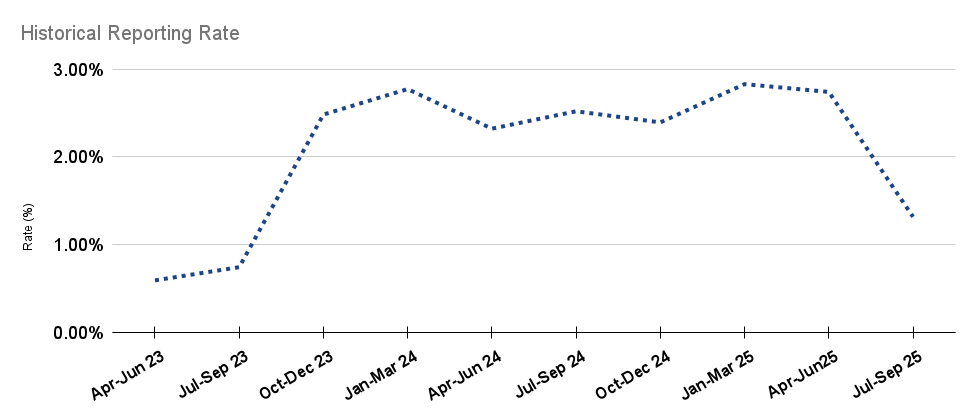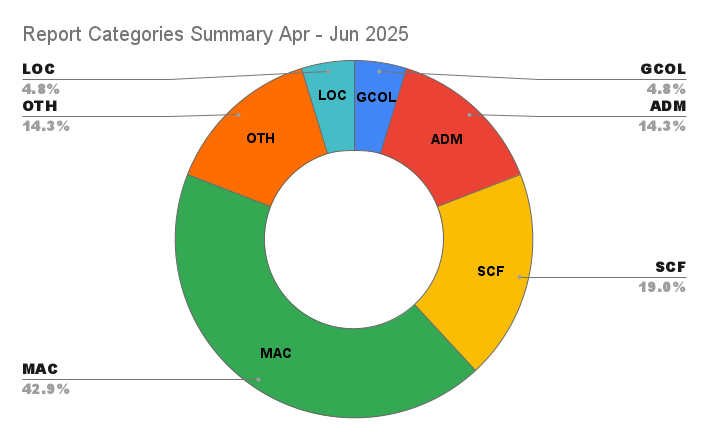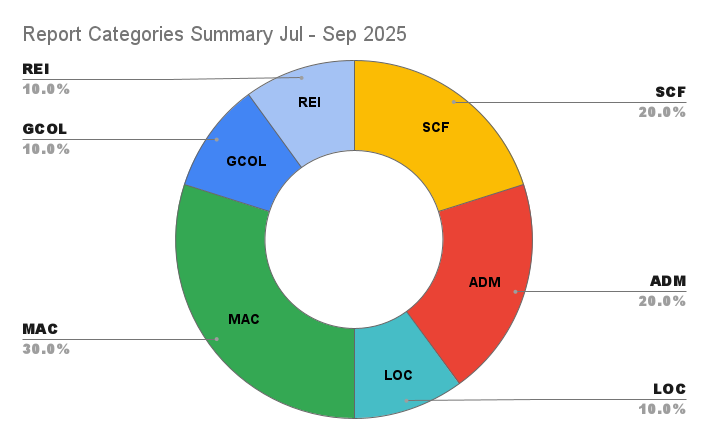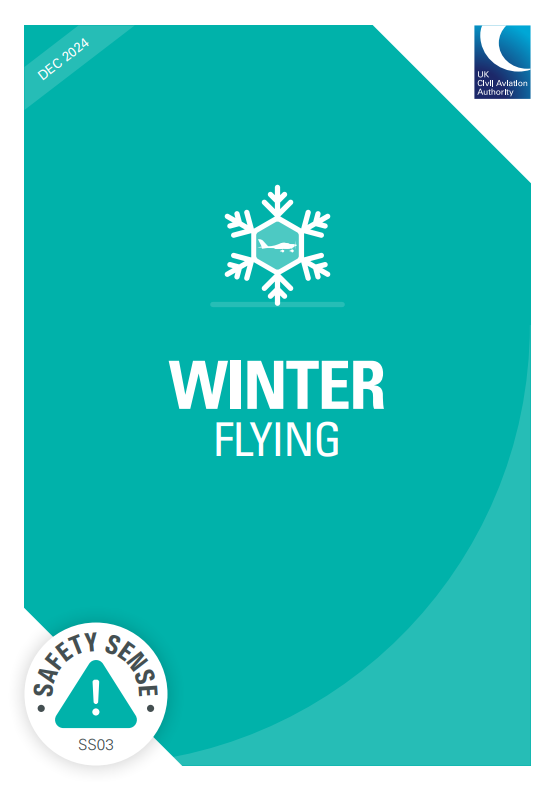Semet Safety Update – Mid to Late 2025
‘Kilo Juliet’ At Sunset
As we move into the final quarter of 2025, we’re taking a moment to review our safety performance across the year so far. Between April and September, our club has continued to focus on reporting, analysis, and proactive improvements to maintain a strong safety culture at SEMET.
Reporting Overview
SEMET Aviation Safety reports rate as a percentage of movements
From April to June, the overall reporting rate remained steady at 2.7% of movements, continuing the stable trend we’ve seen over the last 18 months. This consistency shows strong engagement in our safety system, although we continue to encourage even higher levels of reporting to reach our target rate of 3.5%.
Between July and September, the reporting rate dipped to 1.3%, the lowest of the year. This can be potentially attribute to instructor turnover and the onboarding of new team members, where safety reporting awareness may not yet have been fully established. Continued updates like this one help to reinforce the importance of safety engagement across all roles and members in our club.
Report Categories
SEMET Aviation report categories as a percentage of total reports
Airspace Infringements and MAC Reports
The rate of airspace infringements rose notably in the first half of this period, contributing to the majority of MAC (aircraft conflict) reports. Several involved operations in and around the EGLK ATZ. While the number of these incidents is higher than usual, increased self-reporting has allowed us to implement specific mitigations, including targeted briefings and improved route awareness training.
Positive Indicators
There are encouraging signs that our enhanced post-maintenance checklist, introduced earlier this year, is reducing technical issues, with a smaller proportion of SCF (system/component failure) events than in previous reporting periods.
Our safety culture continues to strengthen through transparent reporting, data-driven improvements, and rapid response to identified risks.
Safety Report Roundup
Below we have included a selection of our reports for the period April - September this year. This is to help build awareness of events that do take place. It may be useful to reflect on what has occurred. Think of ways you may be able to reduce the chances of similar occurrences in the future, or how you may react safely if it happens to you.
A lot of the causes relate to the pilot competencies we discuss during training. Be sure to ask an instructor if you have any questions surrounding the training of competencies.
Ground or Runway-Related Incidents
Line-up clearance cancelled by ATC while aircraft was already entering runway — caused by ATC decision
Landing without reporting final or FISO confirmation of clear runway (“land at your discretion”) — caused by pilot distraction and workload
Aborted take-off due to sudden tailwind and poor climb performance — caused by environmental conditions (gusts/windshear)
System / Component Failures
Brake pedal became disconnected in flight, leading to asymmetric braking on landing — caused by a defective component
Radio failure after take-off, only weak reception after landing — caused by faulty headset jack
Repeated loss of brake pressure on one side — caused by seal failure in braking system
Engine ECU A failure warning during take-off, take-off rejected — caused by defective engine control unit
Exhaust detached and found missing after flight — caused by component failure
Mid-Air / Airspace Infringements
Minor controlled airspace infringement (approx. 100 ft) — caused by planning error / complacency
Infringement near London due to distraction during radio frequency change — caused by distraction
Opposite-direction take-offs at a non-controlled airfield, near miss — potentially caused by radio mis-setting and procedural lapse
AIRPROX with low-visibility aircraft not seen in haze — caused by visual limitations / lack of electronic conspicuity
Brief entry into controlled airspace (0.3 NM) — caused by distraction and loss of situational awareness
LTMA infringement during descent — caused by situational awareness lapse
Conflict in circuit due to incorrect join by another aircraft — caused by third-party pilot error
Forced go-around due to another aircraft joining incorrectly — caused by third-party pilot error
Bird activity and aircraft joining circuit without calls — caused by third-party error and wildlife hazard
Student entered controlled airspace on solo navigation flight — caused by navigation error and distraction
Jet joined circuit and overtook training aircraft above — caused by sequencing and situational awareness issues
Administrative / Operational Errors
Unresolved tech-log defects causing confusion and duplication — caused by poor communication and record-keeping process
Fuel unavailable at destination requiring replanning — caused by inadequate planning / fuel management awareness
Maintenance defect tracking gap between bases — caused by process and communication weakness
Loss of Control / Human-Factor Events
Engine rough running due to unlocked primer — caused by checklist omission
Fuel cap left off after shared refuelling task — caused by communication breakdown
Fuel splash into pilot’s eyes while refuelling — caused by procedural error / poor situational awareness
Door not latched properly and secured in flight — caused by minor component issue and check omission
Taxied with tie-down still attached — caused by time pressure and human error
Go-around due to bird activity on runway — caused by environmental (wildlife) hazard
Typical Cause Themes
| Theme | Description / Typical Causes | Frequency / Trend |
|---|---|---|
| Human Factors | Distraction, complacency, checklist omissions, communication errors, time pressure, navigation mistakes. | Most frequent – ~40% of events |
| Defective Components / Technical Failures | Mechanical, electrical, or structural defects (e.g. brake, radio, exhaust failures). | Common – ~20% |
| Third-Party Actions | Errors or poor airmanship by other pilots, ATC issues, or conflicting circuit joins. | Moderate – ~15% |
| Procedural / Communication Weaknesses | Admin errors, poor record-keeping, weak coordination, or missed planning steps. | Moderate – ~15% |
| Environmental / Natural Factors | Wind changes, bird activity, visibility issues, or other natural hazards. | Occasional – ~10% |
Distraction and Stress In Flying
The above reports show a continual presence of human factors themes involved with safety events.
Readers of our previous update may remember we focused on human factors and reducing the risk when they become involved in aviation. For those who missed it, please find a link below and scroll down to explore more ideas to help deal with the threat:
Case Study: AIRPROX North West of Blackbushe
Earlier this summer one of our aircraft was involved in an AIRPROX event leading to an insightful investigation by the UK AIRPROX Board (UKAB).
‘An Airprox is a situation in which, in the opinion of a pilot or air traffic services personnel, the distance between aircraft as well as their relative positions and speed have been such that the safety of the aircraft involved may have been compromised.’
The board categorised this incident as risk category A in their assessment, this is their highest risk category. The reasons to why this event was judged as severe can be read about in the report:
A reminder that we have SkyEcho 2 (ADS-B) electronic conspicuity (EC) devices available to be borrowed from operations for all flights. These can help build situational awareness for you and other pilots using compatible moving maps and integral traffic awareness systems. Please ask a flight instructor for more information on set up and use of these devices.
Looking Ahead
As we move into a colder part of the year we can revisit some previous events associated with the change of season.
Hoar Frost on a SEMET PA28
De-icing
De-icing brings a different aspect to our operation for those early morning starts during the winter period. Previous events have been associated with time pressure after de-icing. So it is useful to consider building in extra time to your preparation if de-icing may be required.
Some useful considerations may include:
Leaving at least 30 minutes extra for pre-flight time when planning to de-ice
Ensuring you are aware of the location and availability of our club de-icing equipment
If you are unsure how or when to de-ice ask an available flight instructor or use the CAA guidance below
Previous reports have also indicated a potential lack of guidance on using the de-icing equipment we have at SEMET, so it’s worth us having a closer look.
We use Type 1 de-icing fluid usually diluted to a 50:50 ratio with warm water. Type 1 fluid is designed for ice removal only. It doesn’t guarantee any significant lasting effect to prevent ice returning in freezing conditions with moisture present.
It’s common to use almost an entire 5 Litre container of diluted fluid on one aircraft to clear all ice and snow. The Safety Sense Leaflet on winter flying specifies, ‘All surface frost, ice or snow must be removed from the aircraft before flight. Even a very light film of frost may reduce lift by as much as 30% and drag by 40%.’
Pay particular attention to wings tail and control surfaces and ensure any guidance in your aircraft POH/AFM is followed.
Brushes, cloths, containers, sprayers and fluids are all available from operations.
Just Culture Reminder
Our Just Culture within SEMET accepts that as humans, we all make errors from time to time, there is no getting around that. When reporting these unintentional errors an individual should feel comfortable in doing so and SEMET will endeavour to support the reporter in any development required. If as pilots we don’t feel supported, it makes it hard to bring up errors. Our Just Culture should empower you to make safety reports that have included your own errors with no judgement. No risk of penalty should exist if errors/actions are unintentional and not subject to significant negligence.
Further Reporting
As always thank you to all those that have submitted reports over the last 6 months, as you can see each report really does help us improve, through increased trend analysis.
But we do need to do more, our recent drop off in reporting rate can be easily cured through all of us reporting anything safety related to share with others, potentially helping them prepare for or avoid a similar circumstance.
How Do I Report?
QR codes can be scanned from the clubhouse walls
Access via Member’s Portal section of the website
Direct link via the button below:
Any other questions, you can contact the safety team via email: safety@semetaviation.co.uk
The more we know, the safer we grow. Whether it’s something that made you uncomfortable, a near-miss, or a system quirk—if it catches your attention, it’s worth reporting.
We are only as safe as you makes us.










